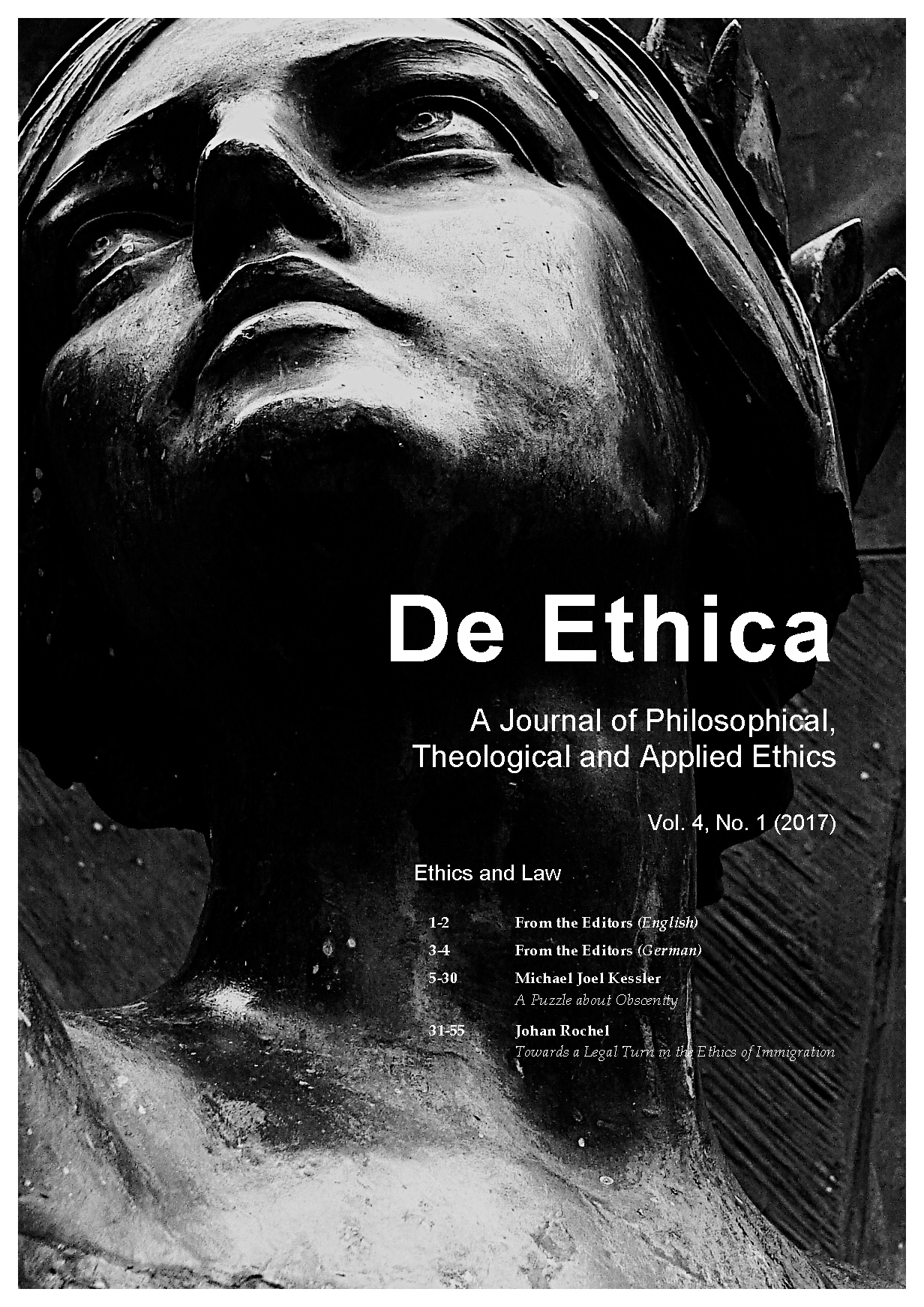A Puzzle about Obscenity
DOI:
https://doi.org/10.3384/de-ethica.2001-8819.17415Keywords:
Obscenity, Mill, Moral Harm, Freedom of Expression, LawAbstract
Laws against sexual obscenity rely on a distinction between explicit materials that merely offend and materials that cause something worse than offense. While most offensive content is protected under the banner of freedom of expression, obscenity is not. In this paper I try to locate a distinctive harm in the case of obscenity, that would justify prohibiting this material while permitting other kinds of offensive content. I argue that the best case for laws against obscenity relies on the concept of moral harm. If we rely on Mill’s Harm Principle and moral harm is a real harm, then it could be used to justify the distinction between protected and unprotected sexually explicit speech. I argue this demonstrates a weakness in the Harm Principle as a liberal principle of justice. By giving weight to moral harm, Mill’s principle risks eroding an important distinction between the public and private domains.References
Boyce, Bret. ‘Obscenity and Community Standards’, Yale Journal of International Law 33 (2008), pp. 299-513.
Brink, David. ‘Millian Principles, Freedom Of Expression, And Hate Speech’, Legal Theory 7 (2001), pp. 119–157. DOI: 10.1017/S1352325201072019
Brecher, Bob. Getting What You Want? A Critique of Liberal Morality. London: Routledge, 1998.
Carroll, Jason S.; Laura M. Padilla-Walker, Larry J. Nelson,; Chad D. Olson; Carolyn McNamara Barry, and Stephanie D. Madsen. ‘Generation XXX: Pornography Acceptance and Use among Emerging Adults’, Journal of Adolescent Research 23:1, 2008), pp. 6-30.
Criminal Justice and Immigration Act
Criminal Justice and Courts Bill - Extension of the offence of Extreme Pornography. Online at: https://www.gov.uk/government/uploads/system/uploads/attachment_data/file/322160/fact-sheet-extreme-porn.pdf (accessed 2017-05-04).
Diamond, Milton. ‘Pornography, Public Acceptance and Sex Related Crime: A Review’, International Journal of Law and Psychiatry 32 (2009), pp. 304–314. DOI: 10.1016/j.ijlp.2009.06.004
Dworkin, Andrea. Pornography: Men Possessing Women. New York: Putnam, 1981.
Dyzenhaus, David. ‘Mill and the Harm of Pornography’, Ethics 103:3 (1992), pp. 534–551. DOI: 10.1086/293423
Feinberg, Joel. The Moral Limits of the Criminal Law Volume 3: Harm to Self. Oxford: Oxford University Press, 1989. DOI: 10.1093/0195059239.001.0001
Feinberg, Joel. The Moral Limits of the Criminal Law Volume 4: Harmless Wrongdoing. Oxford: Oxford University Press, 1990.
Honderich, Ted. ‘On Liberty and Morality-Dependent Harm’, Political Studies, 30:4 (1982), pp. 504-514. DOI: 10.1111/j.1467-9248.1982.tb00556.x
Itzin, Catherine, Ann R. Taket and Liz Kelly. The Evidence of Harm to Adults Relating to Exposure to Extreme Pornographic Material: A Rapid Evidence Assessment. Ministry of Justice research series, 11/07 (London: Ministry of Justice, 2007).
Jochelson, Richard, ‘After Labaye: The Harm Test Of Obscenity, The New Judicial Vacuum, And The Relevance Of Familiar Voices, Alberta Law Review. 46:3 (2009), pp. 741-767.
Johnson, Paul. ‘Law, Morality and Disgust: The Regulation of “Extreme Pornography” in England and Wales’, Social & Legal Studies 19:2 (2010), pp. 147-163. DOI: 10.1177/0964663909351438
Kang, John M. ‘Taking Safety Seriously: Using Liberalism To Fight Pornography’, Michigan Journal of Gender & Law 15:1 (2008), pp. 1-40.
Koppelman, Andrew. ‘Does Obscenity Cause Moral Harm?’, Columbia Law Review 105:5 (2005), pp. 1635-1679.
Krcmar, Marina, Kristie Farrar and Rory McGloin. ‘The Effects of Video Game Realism on Attention, Retention and Aggressive Outcomes’, Computers in Human Behavior 27:1 (2011), pp. 432–439. DOI: 10.1016/j.chb.2010.09.005
Lambert, Nathaniel M., Sesan Negash, Tyler F. Stillman, Spencer B. Olmstead and Frank D. Fincham. ‘A Love That Doesn’t Last: Pornography Consumption and Weakened Commitment to One’s Romantic Partner’, Journal of Social and Clinical Psychology 31:4 (2012), pp. 410-438. DOI: 10.1521/jscp.2012.31.4.410
Langton, Rae. ‘Whose Right? Ronald Dworkin, Women, and Pornographers’, Philosophy and Public Affairs 19:4 (1990), pp. 311-359.
Ley, David, Nicole Prause and Peter Finn. ‘The Emperor Has No Clothes: A Review of the “Pornography Addiction’’ Model’, Current Sexual Health Reports 6:2 (2014), pp. 94-105. DOI: 10.1007/s11930-014-0016-8
Long, Julia. Anti-Porn: The Resurgence of Anti-Pornography Feminism. London: Zed Books, 2012.
MacKinnon, Catherine A. Feminism Unmodified: Discourses on Life & Law. Cambridge, MA: Harvard University Press, 1987.
Mill, John Stuart. ‘On the Subjugation of Women’ (1869), in On Liberty and Subjection of Women, edited by Alan Ryan. London: Penguin Classics, 2006.
Mill, John Stuart. On Liberty (1859), edited by Mary Warnock. Oxford: Blackwell: 2003.
McGlynn, Clare, and Erica Rackley. ‘Criminalising Extreme Pornography: A Lost Opportunity’, Criminal Law Review 4 (2009), pp. 245–260. DOI: 10.1111/j.1467-6478.2014.00683.x
McGlynn, Clare, and Ian Ward. ‘Would John Stuart Mill have Regulated Pornography?’, Journal Of Law And Society 41:4 (2014), pp. 500-522.
Obscene Publications Act
Rackley, Erika, and Clare McGlynn. ‘Prosecuting the Possession of Extreme Pornography: A Misunderstood and Misused Law’, Criminal Law Review 5 (2013), pp. 400–405.
Scanlon, Thomas M. ‘Freedom of Expression and Categories of Expression’, University of Pittsburgh Law Review 40 (1978-1979).
Stone, Geoffrey R. ‘Restrictions of Speech Because of its Content: The Peculiar Case of Subject-Matter restrictions’, The University of Chicago Law Review 46:1 (1978), pp. 81-115. DOI: 10.2307/1599289
Sumner, Leonard W. The Hateful & The Obscene. Toronto: University of Toronto Press, 2004. DOI: 10.3138/9781442681439
Waldron, Jeremy ‘Mill and the Value of Moral Distress’, Political Studies 35:3 (1987), pp. 410-423. DOI: 10.1111/j.1467-9248.1987.tb00197.x
Watson, Mary Anne, and Randyl D. Smith. ‘Positive Porn: Educational, Medical, and Clinical Uses’, American Journal of Sexuality Education 7:2 (2012), pp. 122–145. DOI: 10.1080/15546128.2012.680861
Downloads
Published
How to Cite
Issue
Section
License
Copyright (c) 2017 Kessler

This work is licensed under a Creative Commons Attribution-NonCommercial 4.0 International License.

